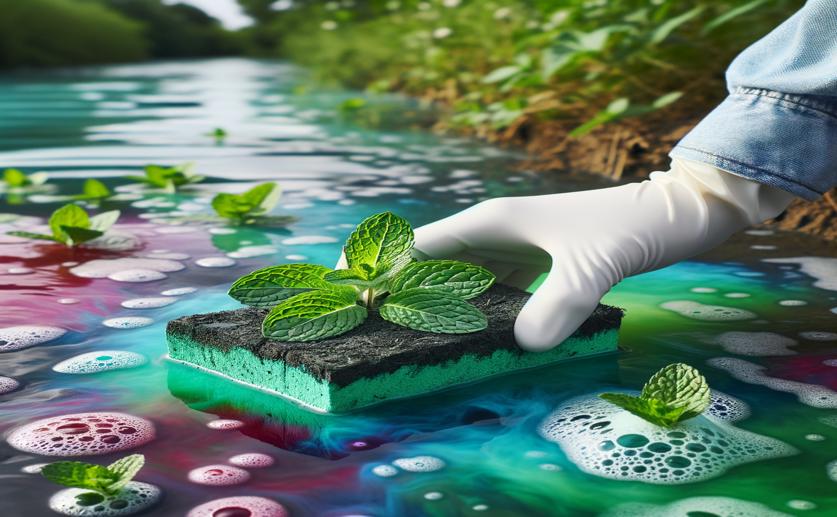New Eco-Friendly Mint Biochar Cleans Up Water Dye Pollution

Image Source: Natural Science News, 2024
Key Findings
- Researchers in Egypt developed biochar from mint stalks and lemon peels to remove dye from water
- Mint-stalk biochar removed up to 93.6% of methylene blue dye in 90 minutes and can be reused
- The biochar works by attracting and holding dye molecules, a process that is efficient and eco-friendly
In recent years, the release of dyes into water bodies has become a significant environmental concern. Methylene blue (MB), a common industrial dye, is particularly troublesome due to its persistence and toxicity. Finding effective ways to remove such pollutants is critical for environmental protection and public health. Researchers at Mansoura University have developed a new method to tackle this issue by using biochar, a carbon-rich material produced from the pyrolysis (thermal decomposition in the absence of oxygen) of organic matter[1].
The study at Mansoura University focused on creating biochar from two unconventional sources: mint stalks and lemon peels. These agricultural by-products were transformed into mint-stalks derived biochar (MBC) and lemon-peels derived biochar (LBC), which were then tested for their ability to adsorb MB from water.
The researchers found that MBC had a higher surface area and carbon content compared to LBC, which translated into a superior performance in removing MB from water. When used at an optimal dose, MBC removed up to 93.6% of MB within 90 minutes. This efficiency is notable, especially considering that the adsorption capacity of MBC remained high even after five cycles of use, indicating its stability and potential for reuse.
The adsorption process, as determined by the study, involves electrostatic interactions, hydrogen bonding, and π-π stacking. These are ways in which the MB molecules are attracted and held onto the biochar surface. This finding aligns with earlier research which showed that biochar could remove various contaminants from water through similar mechanisms[2].
The study also explored the effects of varying the concentration of MB and the dose of biochar. It was observed that increasing the MB concentration decreased the removal efficiency, but this could be offset by increasing the amount of biochar used. This scalability is crucial for practical applications, where contaminant concentrations can vary widely.
Further, the researchers modeled the adsorption process using the pseudo-second-order and Langmuir models, which are mathematical ways to describe how adsorption occurs over time and how much contaminant can be adsorbed, respectively. The adsorption was found to be endothermic (absorbs heat) and spontaneous, suggesting it is favorable under natural conditions.
The study's implications extend beyond dye removal. The biochar produced could also be used in other environmental applications, such as activating advanced oxidation processes, a method previously shown to degrade atrazine, a harmful herbicide[3]. This versatility makes biochar a valuable tool in the environmental remediation arsenal.
The research from Mansoura University not only provides a new solution to the dye pollution problem but also upcycles agricultural waste, contributing to a circular economy. It builds on previous studies that have explored biochar's potential in removing pharmaceuticals from wastewater[2] and its use in conjunction with other materials to degrade pesticides[3]. Additionally, it offers an alternative strategy for managing waste from food processing, similar to how solid digestate from food waste was used for biochar production[4].
In conclusion, the innovative use of mint stalks and lemon peels to create effective biochar for dye adsorption presents a promising, eco-friendly approach to water purification. The research demonstrates the potential for wider application, from treating industrial wastewater to safeguarding our water resources. With further development, this technology could be scaled up, offering a sustainable solution to one of the pressing environmental challenges of our time.
EnvironmentSustainabilityBiotech
References
Main Study
1) Novel mint-stalks derived biochar for the adsorption of methylene blue dye: Effect of operating parameters, adsorption mechanism, kinetics, isotherms, and thermodynamics.
Published 3rd April, 2024
https://doi.org/10.1016/j.jenvman.2024.120738
Related Studies
Related Articles





 17th January, 2024 | David Palenski
17th January, 2024 | David Palenski